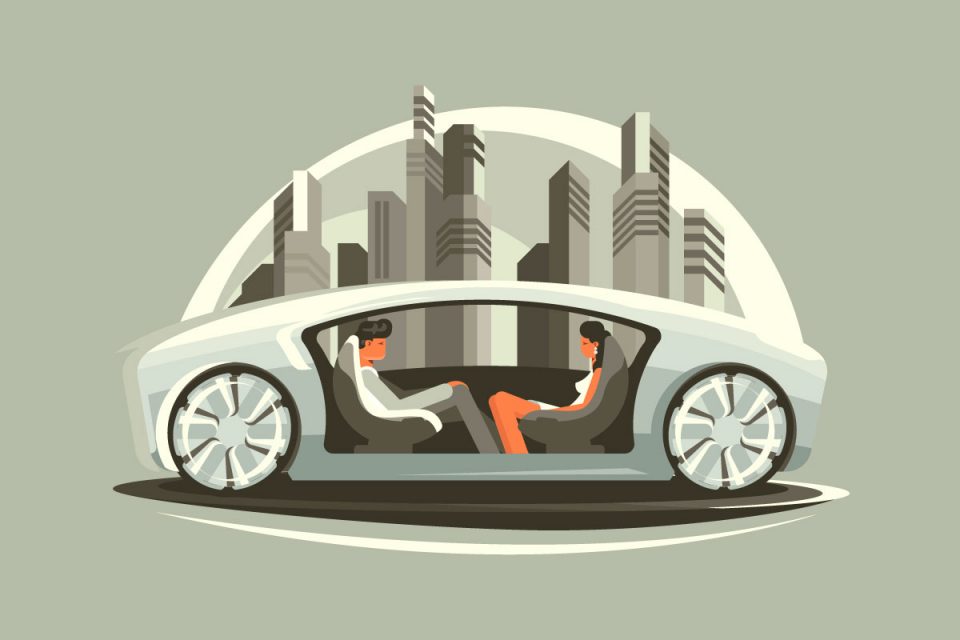
With the race to roll out autonomous vehicles thick with industry giants in the tech and traditional car-making sectors, why are Silicon Valley’s top venture capital firms even investing in upstart entrepreneurs looking to get in the game?
Bottom line: The market is huge – both in terms of the types of products and services that will be needed in the age of robocars, and more importantly, the opportunity to solve serious problems like traffic collisions, congestion and pollution. Achieving full autonomy has broad implications for land use, car ownership and industrial-scale transport such as cargo shipping.
Sure, the way ahead may seem daunting for the aspiring entrepreneur. Waymo, the company born out of Google’s self-driving car project, has now logged about three million miles on city streets. Meanwhile, Apple has reportedly filed for patents on technology related to driverless-car systems. Rideshare companies and auto manufacturers alike are also inching forward, rolling out features that make their vehicles incrementally more autonomous.
And yet, take just three of many Silicon Valley startups in the autonomous-vehicle space: Together, they have raised a total of $400 million in capital to date. Zoox, which is developing a self-driving car from the ground up, has raised $290 million thus far. Drive.ai, which is building integrated hardware and software retrofit kits that businesses can install on their fleets to make them fully autonomous, has raised over $60 million in funding. Mapbox, which has a division devoted to developing a mapping system for autonomous vehicles, has also raised $60 million.
“It’s a question of when and how, not if,” said Steve Jurvetson, a principal partner at venture capital firm DFJ. “Rest assured that all vehicles will be autonomous eventually.”
Jurvetson is widely known and acclaimed for investing in companies that are at the forefront of technology and are poised to transform major industries. He made early bets on Tesla and SpaceX.
“The entrepreneurs at the helms of the kinds of companies I look for are pursuing a greater mission than profit arbitrage,” Jurvetson told Forbes in 2016. “The companies we invest in are doing things that extend beyond the moment and will have long-term implications for how we live, work and play.”
A Driving Focus
In terms of optics, the emphasis on transforming society may give smaller startups an edge in the autonomous-vehicle space over the titans of Motor City and Silicon Valley. For all the resources that Apple, Google and Detroit’s “big three” have at their disposal, they are first defined by their legacies – namely, high-end devices, Internet search and ads, and gas-guzzling cars. Startups, at their very core, can embody their promises of change from the get go.
“We started Drive.ai because we believe there’s a real opportunity to make our roads, our families, and our communities safer,” the company’s founders professed publicly this summer. “We also believe that self-driving vehicles will be the efficiency engine of the transportation network.”
Saving lives and making us more efficient – those words aren’t exactly in the mission statements of industry incumbents. But they are precisely what autonomous-vehicle entrepreneurs hammer home when they talk about their company.
“The fact is, 40,000 Americans are dying every year in car accidents. More than a million are getting injured, and globally, you have over a million people dying,” Jesse Levinson, co-founder and chief technology officer at Zoox, said recently at Stanford. “When that’s your starting point, there’s a lot of ways to improve the technology.”
In that same talk, for the DFJ Entrepreneurial Thought Leaders series, Levinson and fellow co-founder Tim Kentley-Klay described how the fleet of self-driving taxis they are developing will address the extreme inefficiencies of conventional car ownership: from the familiar fact that individually owned autos spend more than 90 percent of the time parked, to the current reality that people spend tens of thousands of dollars on vehicles that will be technologically in the dust in just a few years.
Find a Niche
For Drive.ai, its founders didn’t set out to launch a startup. As students in the Stanford Artificial Intelligence Lab, they were working on “deep learning” – a form of AI that allows a machine to develop an increasingly sophisticated understanding based on examples it is given. They saw how a dynamic decision-making system based on deep learning could fare better than task-specific algorithms in the infinite and unpredictable conditions that human drivers face everyday.
Once they started testing how well their system could perceive different conditions, the engineers began to think they had a better technology solution than those being developed in the industry. The validation of peers in the field, who were “blown away” when the students shared their results, also gave them the confidence to put their Ph.D. studies on hold and start a company, according to Drive.ai Co-Founder Brody Huval.
From a business perspective, they decided to build self-driving vehicle systems – the “brains,” as they like to say – specifically for businesses. Companies represent a larger revenue stream than the consumer market, and importantly, they tend to operate fleets within a fixed area. Such “geo-fencing” allows for a quicker deployment than the more widespread rollouts planned by other autonomous-vehicle makers.
“We felt that this new approach to making self-driving car brains would actually lead to a solution that’s more scalable, safer, and ultimately could be deployed a little bit quicker,” said Drive.ai Co-Founder and CEO Sameep Tandon. “Those two dimensions are also very important to us as we think about what the world will look like in an autonomous-vehicle-driven society.”
Meanwhile, the founders of Zoox are focused on “autonomy as a service,” targeting people in crowded cities who would rather not deal with the hassles and costs of car ownership. In order to not tip off competitors, they have shared few specifics about the all-electric vehicle they’re developing. Also, they are pursuing a “full-stack” strategy, partly to minimize risks and dependencies associated with the use of components and technology made by others.
“We want it to be safe. We want it to be clean. We want people to be able to jog and not be getting tailpipe emissions,” Kentley-Klay explained when he and Levinson spoke at Stanford in May. “And we want it to be accessible for the whole community, low cost, and we want it to be a wonderful product experience.”
For the team at Drive.ai, it also comes back to impact: “It takes about the same amount of time to build something like Facebook for cats as it does to build an autonomous-vehicle company,” Huval said. “They both take pretty much all of your working hours. But if you’re able to focus on something that you think will be a high-impact area, something that’s large and transformative for society, you’re going have a lot more motivation and be able to stick to it through tough times.”
Expanding Ecosystem and Opportunities
As technology futurist Sudha Jamthe says for her Stanford Continuing Studies course The Business of Self-Driving Cars, “We are witnessing a historic moment in car manufacturing and the birth of new business models.” But as attractive as a wide-open market may seem, aspiring entrepreneurs must also understand the industry standards and regulations already in place to ensure they know the landscape and build products that comply.
For instance, carmakers refer to vehicle autonomy along a spectrum of five levels, as defined by the National Highway Traffic Safety Administration. They were first developed by the Society of Automotive Engineers and, in short, are as follows:
- Level 1: A specific function, like steering or accelerating, is automated.
- Level 2: Multiple automated features can work together, like cruise control and lane centering. Still, the driver must always be ready to take back control.
- Level 3: The vehicle can drive itself, but a person is still required to intervene if necessary.
- Level 4: The vehicle is fully autonomous but limited to certain conditions like times of day or geographic locations.
- Level 5: The vehicle is completely autonomous in any driving scenario, regardless of weather, off-road conditions, etc.
As for the regulatory environment, the U.S. Department of Transportation in September 2016 adopted the Federal Automated Vehicles Policy, a set of guidelines in 15 areas of vehicle performance that driverless carmakers can voluntarily follow. Unlike the Federal Motor Vehicle Safety Standards – which regulate the design, construction, performance and durability for all cars in the country – the automated vehicle policy isn’t mandatory.
“It’s meant to be a nimble and flexible framework as the technology develops,” said Bert Kaufman, head of corporate and regulatory affairs for Zoox. “There’s a ton of opportunity to innovate, and I think the policy is the government’s way of allowing that to happen.”
Different companies are following their own timelines for the launch of their version of fully autonomous vehicles. Estimates seem to be clustered between 2018 and 2020, when Zoox aims to have its cars on the streets. At the Andreessen Horowitz 2016 Summit, partner Frank Chen stated that Uber hopes to have its entire fleet be driverless by 2030. The Institute of Electrical and Electronics Engineers (IEEE) predicts that, by 2040, three out of every four cars on the road will be driverless.
The vast array of business opportunities for different products and services orbiting autonomous vehicles reflects the rapid expansion of the ecosystem. Autonomous-vehicle makers are desperate for cheaper lidar technology – the laser-radar detection system that sits atop many of today’s self-driving cars like a turret. Opportunities are also emerging in software, data tagging and in many downstream areas currently encompassed by today’s automotive sector.
Just last week, Drive.ai announced that it will soon begin piloting self-driving cars in the San Francisco Bay Area through a partnership with the rideshare startup Lyft. The collaboration underscores how startups can create opportunities for each other as they experiment and explore. “One of the advantages we think we have is our speed, both in technology and business development, ” said Drive.ai Co-Founder Tao Wang.
Jamthe says revenue from self-driving cars is estimated to be $42 billion globally by 2021. And given driverless technology’s potential to upend everything from personal mobility to commercial cargo, DFJ’s Steve Jurvetson says the autonomous-vehicle market will actually engulf the traditional transportation sector.
“Every vehicle will be autonomous, eventually, and there are distinct opportunities in personal mobility – cars and drones – as well as cargo on land, sea and air,” Jurvetson explains. “It will transform urban design. And on the labor-market side, consider for a moment that 20 percent of all jobs globally are driving a vehicle. Of those who have an income-paying job, 20 percent of them are drivers.”
The implications, and so the opportunities, seem then to be endless.







